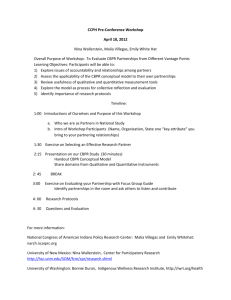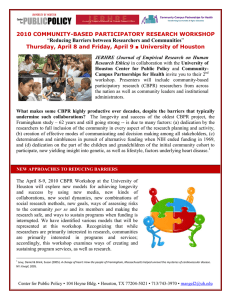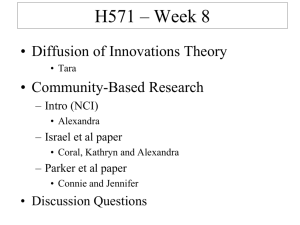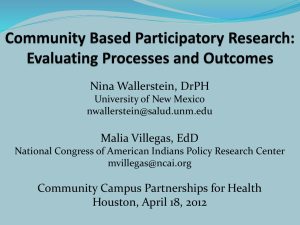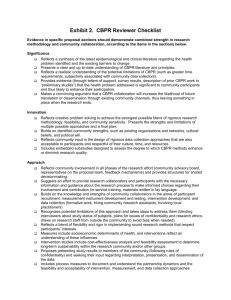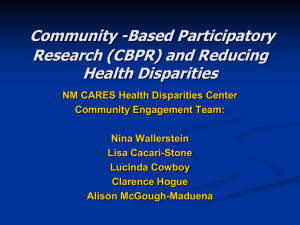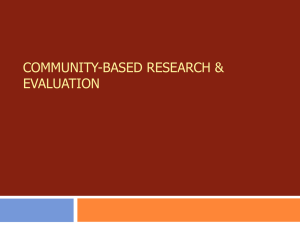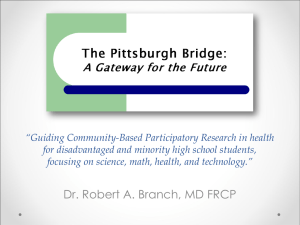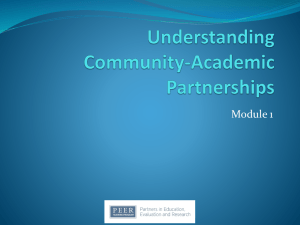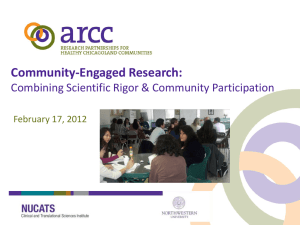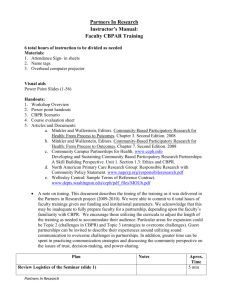Setting the Stage for CBPR
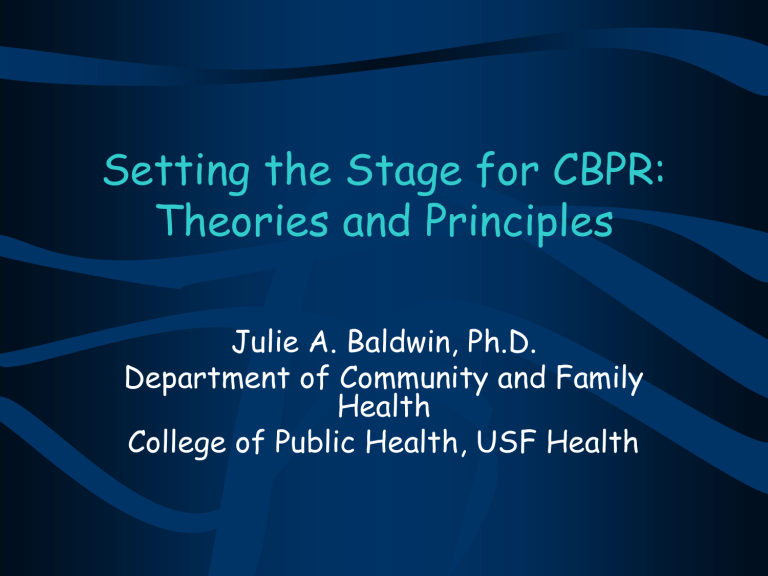
Setting the Stage for CBPR:
Theories and Principles
Julie A. Baldwin, Ph.D.
Department of Community and Family
Health
College of Public Health, USF Health
Objectives
• Describe the background of communitybased participatory research (CBPR)
• Describe and critically discuss key concepts and principles of CBPR
• Discuss some of the challenges of CBPR, as well as the benefits to public health research
Community
• Numerous definitions
• As place - traditional notion
• As social interaction - network of relationships
• As social & political responsibility shared concerns
Key Characteristics of
Community
• Shared sense of belonging and connectedness
• “Manifested in common symbols, language and emotional connections” (Israel et al., 1994, p.151).
• Best Definition: a group of people sharing a sense of collective identity, common values, goals, and institutions
Distinguishing Features of
Community Organization
• Community participation
• Community ownership
• Community competence and empowerment
• Recognition and use of community assets
• Participatory research
Community Participation
• People affected by problem should:
• Set goals
• Plan steps to resolve problem
• Implement changes
• Establish structures to sustain changes
• Outside experts may assist by providing data, models for selecting goals
Community Ownership
• Closely-related to participation
• Local people select issue to address
• Local people have sense of responsibility for and control over programs
• Contributes to likelihood of success, esp. Ability to sustain change
Benefits of Participation
• Participants motivated change
• Activities reinforce commitment
• Opportunities to make public commitment
• Program designers gain participant’s views
• Stronger program design
• Participants gain information
Community Competence
• Community’s ability to set goals and solve its problems
• Outside experts may assist with process
• Help community set goals
• Assist them as they solve problems
Empowerment
• Process of gaining mastery and power over oneself/community to change
• Implications:
• Individuals and communities gain tools and take responsibility for making decisions that affect them
Community-Based Participatory
Research (CBPR)
• Term used widely in health research
• In order for research to be participatory, must meet three goals:
– Research, Action, and Education (which are interconnected)
Community Based
Participatory Research
Participation
&
Education
Research Action
CBPR
“a collaborative process that equitably involves all partners in the research process and recognizes the unique strengths that each brings. CBPR begins with a research topic of importance to the community with the aim of combining knowledge and action for social change to improve community health and eliminate health disparities.”
Israel et al, 1998
Ethical Challenges in CBPR
• Community-Driven Issue Selection
– Involves commitment, time, and skills from the community members (issue: may have other commitments, jobs, family obligations)
– Can true CBPR take place when the research questions come from an outsider to the community?
– Can an outsider with diverse background, ethnicity, and education play a role in the community?
– Community may internally be divided on issues
Ethical Challenges in CBPR
• Participation and its limitations
– Challenge: who truly represents “the community” – constant negotiations to define community
– Community wants different research design than outside researchers;
• Sharing findings and taking action
– Findings may be thought as harmful by the community members; how do you balance researchers’ feelings of obligations to make all findings public?
– Many CBPR programs now have formal or informal research protocols and MOU’s
Ethical Challenges in CBPR
• Researchers may not share the similar community culture
• Cultural misunderstandings, and real or perceived racism, may occur
– Institutionalized racism
– Personally mediated racism based on stereotypic race-based assumptions and judgments
– Internalized racism (reflected in people’s own acceptance of negative messages concerning their own race or ethnic group)
Cultural Competence vs. Cultural
Humility
• “None of us can truly become ‘competent’ in another culture. We can approach crosscultural situations with “cultural humility.”
• Cultural humility is “a lifelong commitment to self evaluation and self-critique,” to redress power imbalances and “develop and maintain mutually respectful and dynamic partnerships with communities.”
Tervalon and
Murray-Garcia, 1998
Changing the Vision of Community
Deficit Mentality
Bundle of
Pathologies
Epidemiology of
Strengths
Community Assets
&
Strengths
Source: H. Jack Geiger
Community Assets: Map and
Enhance
• Individuals
• Leaders
• Regular citizens
• Marginalized members
• Groups and associations
• Local institutions
• Physical assets
Identifying Natural
Community Leaders
When you have a problem, who do you go to for advice?
Who do others go to?
When people in the neighborhood have come together around a problem in the past, did a particular individual or group play a key role?
What things do people tell you you’re good at?
Eng et al, 1990; Israel, 1985; Sharpe, 2000
Community-Campus Partnerships for Health
Available from: http://depts.washington.edu/ccph/commbas.html#Conf
Community Based
Participatory Research in
Health (CBPR)
Research topic
/problem of importance to the community
Combination of knowledge and action for social change
Impact health disparities
“Don’t tell us how much you know until you show us how much you care”
Anonymous

